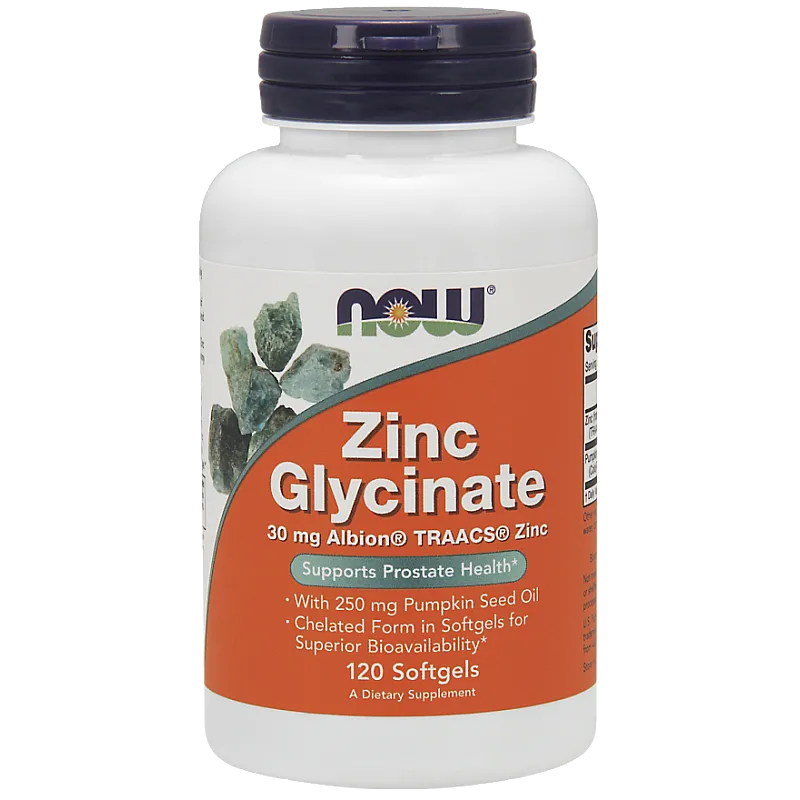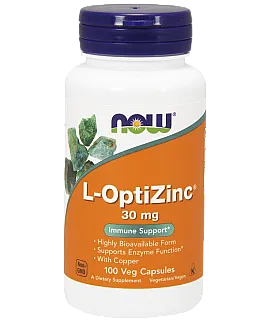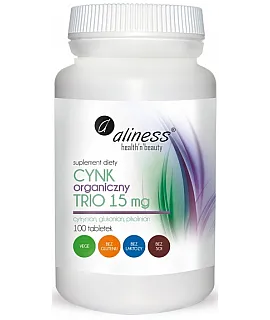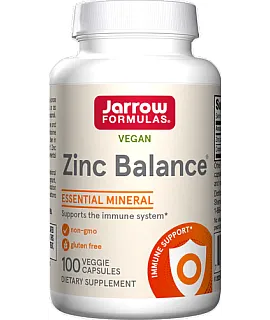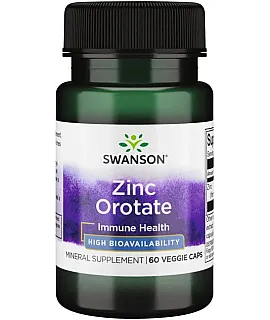- Zinc amino acid chelate
- Zinc with the TRAACS® mark
- Addition of pumpkin seed oil
- Supports the function of numerous enzymes
- Optimizes hormone balance
- Strengthens the antioxidant barrier
- Improves detoxification of the body
- Improves immune system function
- Ensures proper functioning of the cardiovascular system
- Supports prostate function
- Increases the reliability of the reproductive system
- Takes care of the good condition of the nervous system
- Improves the condition of the digestive system
- Optimizes energy metabolism
- Ensures proper vision
- Involves in the regulation of appetite
- Supports liver function
NOW Zinc Glycinate is an agent containing zincglycinate embedded in oil extracted from pumpkin seeds. Supplementing the diet with an important micronutrient, it supports the work of numerous enzymes and hormones, ensures high efficiency of antioxidant and detoxification processes, enables reliable functioning of energy metabolism and efficient operation of numerous systems, including: reproductive, immune, or nervous systems. The required effectiveness of the product is ensured by a form of zinc stamped with the TRAACS® mark, used under license from Albion Laboratories, Inc. The unique combination of zinc and pumpkin seed oil, directs the product for those requiring additional support for the prostate, liver and circulatory system.
Zinc - an important mineral for the functioning of the human body, the requirement of which does not exceed 100 mg/day, thus classified as a micronutrient from a nutritional point of view. Taken from the outside, it is most strongly localized in: muscles and bones, as well as: the brain, skin and numerous organs located in the middle of the body, including: the liver, pancreas, kidneys and spleen. The pool contained in plasma falls predominantly on ions bound almost equally in quantity to albumin and macroglobulin, with a much smaller amount bound to amino acids. The total volume of zinc present in the human body is in the range of 1.5-4 g. The determination of zinc content in the body and the recognition of its necessity for the proper work of the human body was made only in 1926. In turn, since the discovery of the so-called "zinc fingers" in 1985, the element began to be looked at with much more seriousness than before.
Zinc, being an ion with a d10 configuration not susceptible to ligand fields, capable of rapid ligand exchange, and at the same time not hydrolyzed with the formation of hydroxycomplexes in low pH environments and not exhibiting redox properties under biological conditions, is a mineral component capable of performing numerous functions in the body, both during its growth and subsequent maintenance of health. It is important for the work of many enzymes and hormones, the proper reproduction of genetic material, protection of the body from aggressively oxidizing compounds and toxins, as well as the proper functioning of many systems and organs.
Among the most significant dietary sources of zinc are primarily zoonotic products, including: oysters, lobster, shrimp, clams, fish, red meat, liver, milk and eggs. Plant products that are more abundant in the element include: pumpkin seeds, sesame seeds, almonds, buckwheat groats and whole grain products. It is estimated that the requirement for the mineral for an average adult is about 10-15 mg/day.
Properties of zinc
Counteracts oxidative damage
Increasing the synthesis of metalloproteins involved in the reduction of free radical concentrations, acting as a stabilizing component of the structure of superoxide dismutase that breaks down superoxide radical to oxygen molecules and hydrogen peroxide, reducing the oxidation of sulhydryl groups of proteins, regulating the activity of NDPH oxidase and nitric oxide synthase (NOS) by inhibiting the activation of NMDA receptors, Creating the quality of responses under stress conditions by affecting the excitability of the transcription factor NTF2, as well as acting as a metabolic antagonist of copper due to which it normalizes oxidation reactions, especially lipid peroxidation processes, increases the efficiency of the antioxidant barrier involved in protecting the structures of the body from adverse oxidation reactions.
Promotes the construction, development and survival of numerous structures
Being an important component stabilizing the structure of selected enzymes, or acting as an activating cofactor of relevant enzymes, such as RNA or DNA polymerases, as well as enabling the formation of so-called "zinc fingers" involved in the attachment of nucleic acids to proteins, it contributes to the replication of genetic material and the synthesis of new molecules in the body, including proteins. Exerting an antioxidant effect, it protects previously created structures from damage and death.
Limits the development of cancer
By watching over the proper course of the processes of duplication of genetic material and the formation and correct development of relevant structures, as well as minimizing aggressive damage to structures leading to their deformation and abnormal development, it reduces the likelihood of cancer cells.
Responsible for the proper functioning of the immune system
By lowering the toxicity of NK cells against the cells of the body, promoting the synthesis of interleukins IL-1 and IL-6 and TNF-alpha, accelerating the specialization process of unspecialized T lymphocytes, enhancing the activity of monocytes, affecting the adhesion of neutrophils to vascular endothelial cells, influencing the occurrence of programmed immune cell death, and lowering the extent of excessively spread inflammation, it supports the normal functioning of the immune system.
Reduces heavy metal toxicity
As an antagonist of lead and cadmium competing for selected transporters located at the intestinal barrier, it prevents the body from being poisoned by heavy metals.
Promotes maintenance of acid-base balance
Being a cofactor of the first enzyme discovered with its participation, i.e. carbonic anhydrase, it takes part in the release of carbon dioxide through the lungs, or its conversion to bicarbonate and hydrogen ion in the kidneys, thanks to which it supports the maintenance of acid-base balance inside the body.
Supports the functioning of energy metabolism
By creating excitability of selected hormones involved in the quality of work of energy economy, including: thyroid hormones, insulin, or glucagon, as well as ensuring optimal work of organs important for correctness of created concentrations of given hormones, including pancreas, it gets involved in work of energy economy.
Optimizes the endocrine economy of men
Participating in the reactions of transformation of cholesterol to male hormones, promoting the proper synthesis of testosterone and increasing the abundance of androgen receptors, it enhances the activity of testosterone in the body. By reducing the activity of 5α-reductase, it minimizes the conversion of testosterone to its more aggressive form - dihydrotestosterone (DHT), thus ensuring that the optimal level of testosterone potency is maintained in the body. By reducing the potential for estrogen receptor formation, it reduces the occurrence of estrogen overactivity effects.
Increases male fertility
By promoting the formation of testosterone creating efficiency in the process of spermatogenesis, enhancing the maturation of spermatozoa, increasing their survival and motility by nullifying oxidative stress responsible for the destruction of sperm structures, including mitochondria that give the energy necessary for its movement, it is involved in maintaining high male fertility.
Promotes the maintenance of good prostate health
By lowering the excitability of 5α-reductase in the prostate area, thereby reducing the amount of dihydrotestosterone (DHT) formed, it reduces the likelihood of prostatic hypertrophy, helping to preserve the full functionality of the prostate gland.
Allows the digestive system to work properly
Being an ion permanently bound in the structures of carboxypeptidase, it participates in the processes of digestion of small, several-amino-acid peptides. Taking part in normalizing the release of hydrochloric acid into the stomach, it creates an environment favorable for digestive processes and supports the digestive system against unwanted pathogens. In turn, by taking care of the required tightness of the epithelial barrier, it nullifies unwanted leakage of fluids into the intestine.
Maintains good cardiovascular health
Increased zinc intake reducing the possible occurrence of deficiencies, reduces the likelihood of atherosclerotic plaque formation. An adequate supply of zinc also maintains optimal levels of cholesterol and low-density lipoprotein (LDL) circulating in the blood plasma.
Supports nervous system function
Zinc is involved in intrinsic signaling mainly in the form of complexes formed with glutamate. It affects NMDA and GABA receptor signaling and enhances AMPA receptor activity. Interfering with neural signaling, it participates in the overall functioning of the nervous system, as well as in learning and memory processes.
Provides taste sensation and adequate appetite
As a factor that ensures the required catalytic power of gustin (a protein contained in salivary secretions responsible for the development of taste buds by accelerating the differentiation and reconstruction of their cells), it maintains the required ability to feel taste. By guaranteeing the good condition of taste buds and the receptors responsible for taste sensation located on them, it allows you to savor the taste of food, which significantly affects the desire to enjoy the dishes you eat. By being involved in the creation of leptin (satiety hormone) levels following a meal, it is involved in signaling satiation as a result of taking in an adequate amount of food.
Allows maintenance of the ability to see
As an essential component of the intrinsic synthesis of retinoic acid, it is involved in the production of a chemical compound that enables the perception of stimuli from the external world through the organ of sight.
Influences the maintenance of good mental state
By increasing the concentration of brain-affecting neurotrophic factor (BDNF),showing an anti-glutaminergic effect against the occurrence of obsessive-compulsive disorder, and promoting serotonin uptake by selected brain areas, it takes care of mental well-being.
Supports maintaining an attractive appearance
By acting as an anti-inflammatory, antibacterial and drying agent, it accelerates wound healing and supports the maintenance of healthy skin. By reducing the excitability of 5α-reductase in hair follicles, it reduces hair loss caused by excessive production of dihydrotestosterone (DHT).
Pumpkin seed oil - A liquid mixture with a high predominance of compounds classified as lipids in its composition, extracted from plants of the genus Cucurbita in the family Cucurbitaceae, the best recognized representative of which is Cucurbita pepo, a thermophilic, flowering annual plant producing fruits several tens of centimeters in diameter with a hard outer shell and soft flesh, native to America, cultivated in many parts of the world, including Europe. The oil extracted from the seeds of pumpkin fruits is rich in unsaturated fatty acids, primarily oleic and linoleic, as well as triterpenoids, carotenoids and phenolic acids. The largest producers of the oil in question include: Yugoslavia, Austria, or Hungary.
Due to the numerous health-promoting compounds in which pumpkin seed oil is rich, this fat manifests several interesting properties that support the maintenance of the body's well-being:
Through the contained kucurbitacins that destroy the nervous system of parasites residing in the digestive tract, it has an anti-parasitic effect.
As a result of the contained triterpenoids, it manifests antibacterial and antifungal properties.
Providing a large amount of γ-tocopherols, it levels the extent of inflammation, including that occurring in the joints
By lowering previously inflated blood pressure, acting as an anti-erythrogen and strongly lowering blood triglycerides, it promotes the maintenance of cardiovascular health.
Acting cytotoxic against abnormally transformed cells, it reduces the occurrence of certain cancers, including liver cancer.
With its contained beta-sitosterol reducing dihydrotestosterone (DHT) activity in the prostate region, it promotes the maintenance of prostate health
By reducing inflammation and decreasing prostate dysfunction, it alleviates urinary tract discomfort and improves the ability to urinate
Exerting a hypoglycemic effect, it lowers blood glucose levels.
In addition to the health-promoting properties of pumpkin seed oil, its use as a carrier for various substances, including zinc, is supported by its very low content of linolenic acid (0.2%) giving high stability to the vegetable fat in question, and thus high safety of consumption for a relatively long period.
NOW Zinc Glycinate is a product providing glycine chelated zinc, administered in the form of easy to take soft gelatin capsules with additional high quality pumpkin seed oil. By increasing the amount of zinc and raising the supply of important phytochemicals in the diet, it promotes the unwavering work of many enzymes and hormones, raises the efficiency of the antioxidant barrier, supports the detoxification processes taking place in the body, ensures the efficient operation of energy management and takes care of the good condition of the prostate, liver and numerous systems, including the cardiovascular, nervous, digestive, reproductive, immune and proper mental attitude. Adequate effectiveness is guaranteed by TRAACS®-labeled zinc, the use of which is made possible only by the permission and recommendation of Albion Laboratories, Inc. a world leader in the production of the best bioavailable forms of vitamins and minerals. The innovative combination of zinc with pumpkin seed oil used in NOW Zinc Glycinate, above all, provides enhanced support for the maintenance of proper health and performance of the prostate, liver and cardiovascular system.
